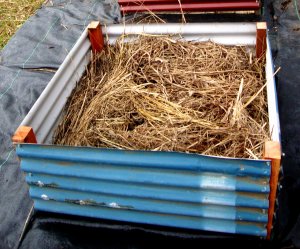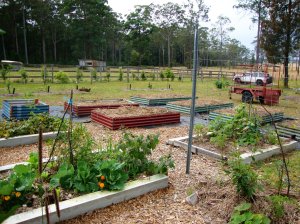Hannah’s Raised Bed 101
I have a special treat today: a guest post by my awesome sister, Hannah. She, Danny and Bodhi finally made it to their block of land in Wauchope, NSW. This was a over a year ago now, after a few false starts and an attempted tour of Australia that made it all the way to Broome, where they took a brief respite from traveling (for a few years). Now located in the beautiful north coast of NSW, they are preparing their 5 acres from the garden up as they get ready to build. Over to Hannah.
There is no perfect garden site – they all have challenges. Our garden is on the opposite side of the country to the sand flats of Perth, and seems to have opposite challenges.
The Port Macquarie region where we live is blessed with frequent rain but our site has crowbar-bendingly compacted soil (we learnt this the hard way), heavy clay of many colours just below the surface, and very determined grass. And on occasion it rains so much that the ground becomes waterlogged for days. On the upside I do like wearing gumboots, makes me feel all farm-like. And the bent crowbar still comes in useful.
Growing food was our first priority as new arrivals to the area. Raised vegie beds seemed the best option for our site, to save hours and hours of digging and soil improving, and to keep the plants up above any possible waterlogging. We have experimented with a few methods for building raised beds, and have recently come up with a design that uses mostly recycled materials and costs very little for the amount of garden you end up with.
We bought a stack of old colourbond sheets in various colours and sizes from our local salvage yard, along with some lengths of hardwood timber (75mm by 45mm or similar). We used a grinder to cut the colourbond sheets into thirds along the valleys in the corrugations. Two of these panels became the two long sides of each rectangular bed, and the remaining panel was cut in half to make the two short sides. The largest beds are around 2400mm x 1200mm, and we have found that a width of 1200mm is the perfect double-reach bed for a short-armed person like me.
The timber was cut to make uprights at each corner, and the colourbond was screwed to it. For the bigger beds we put an extra piece of timber midway along the long sides of the bed so the colourbond wouldn’t bulge in the middle. The beds have no base and sit straight on the ground.
Some of the colourbond sheets were quite small so we cut each of these sheets in half instead of thirds to make smaller, deeper beds, suitable for vegies that need to put their roots down, like carrots, potatoes, or our current favourite, sweet potato.
The beds were so light that we could pick them up and move them around until we had the right locations and combinations of colours. For maximum sunlight to reach all parts of each bed, we have placed them all with the long sides facing north.
To fill the beds we first lined the bottoms with layers of newspaper and cardboard to smother the grass. When we ran out of newspaper and cardboard we used some old clothes (goodbye denim jacket). Then we used a “lasagne” method to fill them, with layers of straw, some topsoil dug from our soon-to-be dam site, food and garden scraps, and some well-composted cow manure. Towards the top is a thick layer of mushroom compost. We collected this ourselves from the mushroom farm after meeting the growers at the farmers’ markets, and finding out that they sell the used compost in blocks really cheaply. Finally a layer of straw for mulch was put on the top. And then the beds were ready to grow things in!
Because of the likely threat of invading kikuyu, couch, and giant parramatta grasses,we surrounded the beds with weed mat which will be covered with wood chips to make wheelbarrow-width pathways.
The whole project – 9 new raised beds with a growing area of about 19 sqm – cost $200 for materials, $100 for mushroom compost, and $50 for weedmat, and took two days of work (fun, actually). The straw was our own overgrown grass. It would have been much cheaper if we had been able to scavenge materials from the tip, but we’re not allowed to do that here.
If we can dedicate ourselves to regular planting, I think these new beds in combination with the few existing ones will provide all our vegies and herbs for a family of three, plus the hungry chooks, rabbit, and guinea pig.




